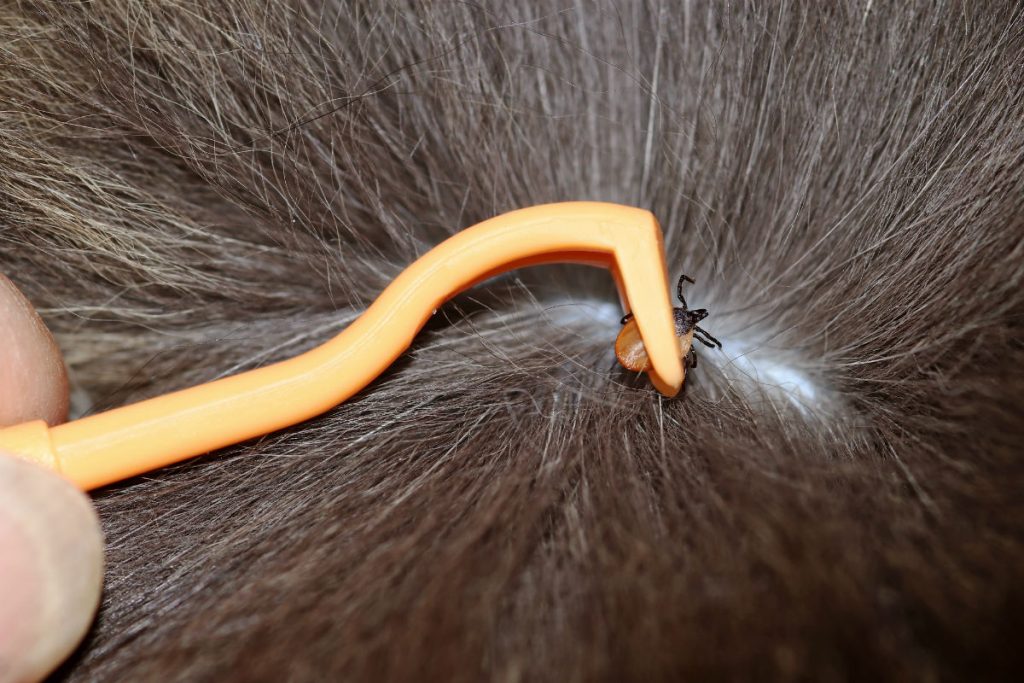Ticks are skin parasites that feed on the blood of their hosts. Ticks like motion, warm temperatures from body heat, and the carbon dioxide exhaled by mammals. This is why they
are attracted to such hosts as dogs, cats, rodents, rabbits, cattle, small mammals, etc. The bite itself is not usually painful, but the parasite can transmit diseases and cause tick paralysis, which is why tick control is so important. (Removing the ticks leads to rapid improvement of the paralysis.)
The minimal amount of time it takes for an attached tick to transmit disease is unknown. The time it takes to transmit diseases is affected by the type of disease organism, the species of tick, etc. However, in general, if a tick is removed within 16 hours, the risk of disease transmission is considered to be very low. Therefore, owners can usually prevent disease transmission to their pets by following a regular schedule to look for and remove ticks.
- Most types of ticks require three hosts during a two-year lifespan. Each tick stage requires a blood meal before it can reach the next stage. Hard ticks have four life stages: egg, larva, nymph, and adult. Larvae and nymphs must feed before they detach and molt. Adult female ticks can engorge, increasing their weight by more than 100-fold. After detaching, an adult female tick can lay approximately 3,000 eggs.
- During the egg-laying stage, ticks lay eggs in secluded areas with dense vegetation. The eggs hatch within two weeks. Some species of ticks lay 100 eggs at a time, others lay 3,000 to 6,000 per batch. Once the eggs hatch, the ticks are in the larval stage, during which time the larvae move into the grass and search for their first blood meal. At this stage, they will attach themselves for several days to their first host, usually a bird or rodent, and then fall to the ground. The nymph stage begins after the first blood meal is completed. Nymphs remain inactive during winter and start moving again in spring. Nymphs find a host, usually a rodent, pet, or human.
- Nymphs are generally about the size of a freckle. After this blood meal, ticks fall off the host and move into the adult stage. Throughout the autumn, male and female adults find a host, which is again usually a rodent, pet, or human. The adult female feeds for 8 to 12 days. The female mates while still attached to her host. Both ticks fall off, and the males die. The female remains inactive through the winter and in the spring, lays her eggs in a secluded place. If adults cannot find a host animal in the fall, they can survive in leaf litter until the spring.
What are the best ways to deal with these blood-sucking parasites?
Outdoor Environmental Control
You can also create a tick-safe zone in your yard by using some simple landscaping techniques that can help reduce tick populations:
- Remove leaf litter.
- Clear tall grasses and brush around homes and at the edge of lawns.
- Place a three-feet wide barrier of wood chips or gravel between lawns and wooded areas to restrict tick migration into recreational areas.
- Mow the lawn frequently.
- Stack wood neatly and in a dry area (this discourages rodents who would be used as tick hosts).
- Keep playground equipment, decks, and patios away from yard edges and trees.
- Discourage unwelcome animals (such as deer, raccoons, and stray dogs) from entering your yard by constructing fences.
- Remove old furniture, mattresses, or trash from the yard that may give ticks a place to hide.
Indoor Environmental Control
If ticks are indoors, flea and tick foggers, sprays, or powders can be used. Inside, ticks typically crawl (they don’t jump) upwards and maybe in cracks around windows and doors. A one-foot barrier of insecticide where the carpeting and wall meet can help with tick control.
Prevent Ticks from Spreading Disease to Your Pet
There are numerous systemic (orally administered) and topical (placed on the skin) medications that are very effective at killing ticks that attach to pets within a few hours. Speak with your veterinary team to find out what the best products are for your pet.
Find and Remove the Ticks
The best way to find ticks on your pet is to run your hands over the whole body. Check for ticks every time your pet comes back from an area you know is inhabited by ticks. Ticks attach most frequently to the pet’s head, ears, neck, and feet, but they are not restricted to those areas.
There are several tick removal devices on the market, but a plain set of fine-tipped tweezers will remove a tick quite effectively.
How To Remove A Tick With Tweezers
- Use fine-tipped tweezers to grasp the tick as close to the skin’s surface as possible.
- Pull upward with steady, even pressure. Don’t twist or jerk the tick; this can cause the mouth-parts to break off and remain in the skin. If this happens, remove the mouth-parts with tweezers. If you are unable to remove the mouth easily with clean tweezers, leave it alone and let the skin heal.
- After removing the tick, thoroughly clean the bite area and your hands with rubbing alcohol, an iodine scrub, or soap and water.
- Dispose of a live tick by submerging it in alcohol, placing it in a sealed bag/container, wrapping it tightly in tape, or flushing it down the toilet. Never crush a tick with your fingers.
- Risk of disease transmission to you, while removing ticks, is low but you should wear gloves if you wish to be perfectly safe. Do not apply hot matches, petroleum jelly, turpentine, nail polish, or just rubbing alcohol alone (the tick must be pulled out after application of alcohol) because these methods do not remove the ticks and they are not safe for your pet.
Written by Chris MacDonald, DVM & Becky Lundgren, DVM




